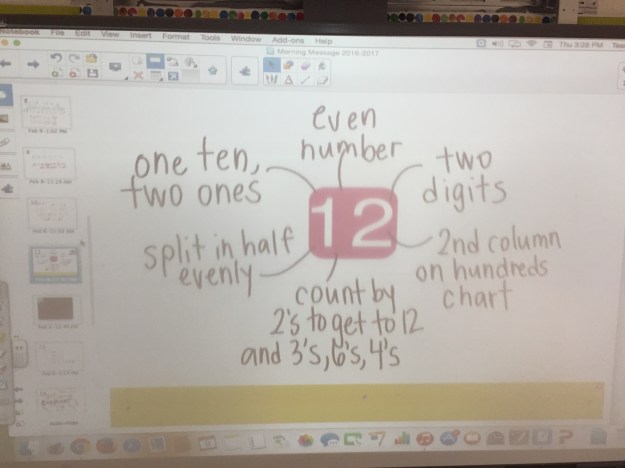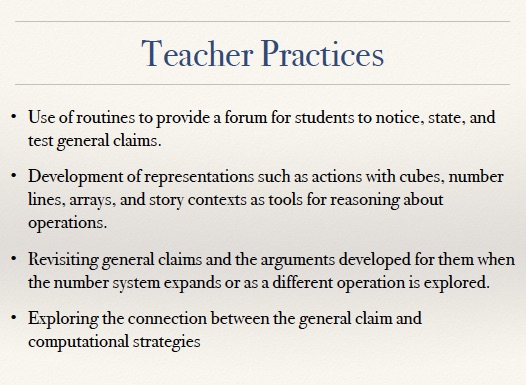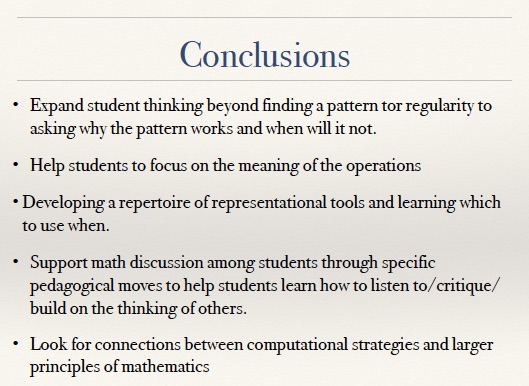Every week, I read so many wonderfully open and honest math blogs from my tweeps, the majority of them found on this list. The blogs span across grade levels, mathematical content, teacher experience, and more impressively, the world. Whether it is a good, bad or ugly lesson, after reading the blogger’s reflections and colleagues’ comments, I am always left with the feeling that if, given the chance to do that same lesson just one more time, there would be significant improvement. Whether it be the organization of the lesson, management of the materials, questioning of the students, sharing out of responses, the task itself, or any of the other countless components of just one math class period, sometimes we all just need someone to say “Cut” on Take 1 and allow us the opportunity for a Take 2. With multiple math classes a day, we often get the chance to adjust a lesson between class periods, however there is not a second chance on that same exact lesson until the following year, nor a significant amount of time to make dramatic changes. I am not saying that we don’t revisit, learn and improve from that point on, however, how amazing would it be to erase a lesson that didn’t go “quite as planned” from a student’s memory and make it even more meaningful for them on our second take? Wouldn’t it be great to answer all of our “What ifs”?
When selected to participate in the project I blogged about here, I had the idea that it could work as a type of lesson study. Since Alicia and I were both 5th grade teachers working on fractions at the beginning of the year and planning a common task, I thought it would be interesting to see how our work together could go above just collaborating around the lesson development to actually creating a “perfect lesson”…or as close as we could possibly get to it. This lesson study would be unique in the sense that all of our work and observations would have to be virtual due to the distance between us. After all of our planning around the 5 practices, our team of Jody, Chepina, Alicia and her math coach, Jennie, decided that I would teach the lesson first, they would all observe the video (through Teaching Channel Teams), we would look at my student work and from there make adjustments for Alicia’s lesson. Being super critical of my own practice in general, it was fairly simple for me to make suggestions for improvement.:)
THE TASK: Part 1: The 5th graders want to raise money for their overnight camping trip by selling cornbread during the school district Chili Cook-Off contest. All of the cornbread pans are square. The first customer, Mrs. Farmer, wants to buy 1/4 of a pan of cornbread that is 1/3 full. What fraction of the whole pan does she want to buy? Part 2: The next customer is the elementary school principal. He wants to buy 5/6 of a pan of cornbread that is 1/2 full. What fraction of the whole pan does he want to buy? Each part also had a part b asking if the pan costs $12, how much would they pay for their piece.
MATHEMATICAL GOAL: Students will develop mathematical generalizations connecting previous understandings of whole number multiplication to multiplication with fractions. (Relational understandings)
Just some of my 5 Practices planning for the task:





With that little bit of background, here is a look into the lesson and the adjustments we made to improve…
My Class: I opened the lesson with a multiplication Number Talk. It was our hope that through the progression of problems, the area model would arise to allow for connections to our task, however in a classic case of anticipating gone bad, there was no area model to be found that day. Great thinking around the multiplication, so I wasn’t disappointed in that, but no array.
Alicia’s Class: After collaborating around the video and my reflection, we decided to start with a number talk on fraction of a whole number. Both of our classes have been working on that and thought it may put students in more of a “fraction mindset” of taking a part of something before beginning the task. We designed the progression: 1/2 of 16, 1/4 of 16, 1/8 of 16, 3/8 of 16 in hopes of pulling out thoughts such as: dividing by 2 is the same as taking half (and 4 for the fourth), a half of a half is a fourth (and the same reasoning for the 1/4 and 1/8), as well as big ideas around equivalence and decomposition. Perfect change.The students shared all of the ideas we wanted to bring out, even as far as pushing the decomposition of 3/8 from 1/8+1/8+1/8 to 3 x 1/8. Not in that exact notation but as 1/8 of 16 = 2, so 3 x 2 = 6.The only thing I wish I had seen (simply because I love when students make connections to previous problems in a NT progression) is 1/4+1/8= 3/8, so 4+2= 6.
Timing was great and the lesson was improving already…..
My Class: As I read the problem aloud and used some listening techniques I learned from @maxmathforum, students had individual think time and moved into working in a group. The first thing I noticed in my students who struggled with entry into the problem was the wording of the problem itself, “1/4 of a pan 1/3 full” muddled the whole and was confusing for them. Also, and I have mixed feelings about this, but the first part allowed for students to get the correct answer by subtracting 1/3 – 1/4 to arrive at 1/12. This is not something we had even thought about. I love the conversation that arises from this, especially because it will not work in the second part, however I thought maybe it did lead us astray from our goal for the lesson.
Alicia’s Class: Alicia launched the lesson with an actual pan of cornbread to show the class, most impressively homemade:) It gave the students a nice visual for their models/representations and I think offered access to those without entry. We changed the wording of the task so her task read, “Mrs. Farmer, walks up to buy cornbread and the pan is 1/4 full. She wants to buy 1/3 of the remaining cornbread. What fraction of the whole pan does she want to buy?” and the same type of wording changes for the second part. We also changed the order of the fractions in the first part so subtraction would not happen them upon the correct answer and in this case be an unreasonable answer of – 1/12. Having not anticipated subtraction, which seems SO obvious now…duh, it was nice to be aware that it may show up in her class and adjust accordingly. Again, I love that conversation of why it is not subtraction and will definitely revisit, but for the sake of our goal, this was much improved.
After part 1, we planned to do a quick share of strategies.
My Class: During the share, I selected and sequenced three papers. My initial thought was to share two correct representations and one with a sticking point I noticed showing up on numerous papers. I chose two students to share who had the array correct, but cut a bit differently and then a subtraction student with two separate pans drawn (one with 1/3 and one with 1/4). My hope was to draw out, from the class, that we were just dealing with one pan and get them thinking about if that made sense. However, the share went longer than anticipated so I decided to leave that out there for them to think about and move around to my few who were sticking with subtraction individually with some strategic questions about the whole.
Alicia’s Class: After seeing the lengthy share in my video, we decided to have Alicia choose three students,with correct representations and different labeling/cutting, with the third being a student who is having some numeric notation around where he/she is seeing multiplication. Alicia’s final sharer ended with his representation and numeric notation showing that he multiplied the numerators and denominators to get the answer. He ended his share wonderfully by saying you not taking 1/3 of the whole you are only taking 1/3 of the 1/4. After talking to Alicia and Jennie afterwards, this student has had some outside experience with multiplying fractions in terms of the algorithm, however struggled a bit to connect it to the why. It was nice to have him share and explain his representation.
Now both classes ventured into part 2 of the task.
My Class: I actually enjoyed this part of my lesson, and was excited to see many of my students up and using the fraction bars to create proofs for their tablemates. The biggest obstacle in my class seemed to be naming the piece. I found that after working through the first part and seeing the share, students were more comfortable with what was happening in the problem and could shade the piece the principal was getting. Many were saying the answer was 5/6, 10/12 or 5 pieces. All correct answers, but that fraction of what whole or 5 pieces the size of what? They had great discussion (even a bit of a heated argument between friends) about whether the answer was 5 or 5/6. I love that they left for lunch still arguing about it…nerdy fabulousness. I did my share with students whose representations were a progression of a student who cut the whole pan into twelfths, another who was just half cut but visualized the other twelve and one who solved it backwards at first, 1/2 of 5/6 and their partner explained it to them and redid it. I thought it was a beautiful picture of the commutative property, that even though the order doesn’t matter in the solution, the picture changes.


Alicia’s Class: I felt this part was very similar between the two classes. Her share was nice (and I wish I had done it) because she brought up one of her students who had it wrong to start and was brave enough to get up and say what she tried that didn’t work and then what worked for her the second time after talking with her group. It was beautiful and connected a lot of learners who tried it the same way the first time. She opened it up to the class for a few comments/questions after each sharer. The students were very nice in giving positive feedback as to how easy to understand the representation was and stressed that the labeling made a big difference.
I am thinking it would help in share outs to focus the students more on what we want them to be noticing, as my buddy @maxmathforum says often. For example, since our goal was to bring out the connection to multiplication, tell students that as others are sharing, be looking at their representation and for the operations they used and why they are using them to get their answer. I would love for it to explicitly come out WHY the numerators and denominators are multiplying and the connection between dividing into 6 parts is the same as multiplying by 1/6. Students did say those things but more in a vague-only-the-teacher-picks-up-on-it kind of way, but I think if we focused their thinking, it may come out more.
The ending (If you are still reading at this point, that is dedication)….
My Class: Through our group planning, we decided to end with a journal entry/exit ticket asking students to think about where they saw multiplication in the work they did. We thought bringing their attention back to their work, having multiplication in mind, would push students to think about many ideas such as taking a part of a part results in a smaller answer, the order of the fractions resulted in the same answer and the denominators multiply because you have to think in terms of the whole. So…I did not really get the results we were looking for. Don’t get me wrong, I had some wonderful responses I used to guide my instruction, however many left me with no idea of what they were thinking about the fraction of a fraction work. This was mainly because of part b in each question asking students about cost. They ALL saw multiplying there…you have 5 pieces, each is $1 so 5 x $1 = $5. That really didn’t help me as a piece of formative assessment work. Here are some of the ones more along the line of matching our goal that we used in adjusting for Alicia’s lesson: (sorry about the lightness, my copier at school obviously has some issues)






Alicia’s Class: After reviewing my student work, we decided for Alicia to use a ticket that had a new problem, 3/5 of a pan 1/2 full, followed by the question about multiplication noticings based only on the first parts of each question and the ticket. MUCH better read of what the students understood. Even if they could not see multiplication, students were able to represent the problem and come to a solution. It was more informative in terms of where to start building with that students and where they were in terms of our mathematical goal. It was interesting to find, in reviewing her tickets, that students she and Jennie thought “had it” during the lesson could not do it independently on the exit pass. We went back to their work for the day and they did seem to have the correct work and responses, however how much of that was table work?
That got me thinking how it would be nice to know what student writing was done during individual think time before the group work started. I think next group task, I will have different-colored colored pencils on the table…one color for individual time and then switch colors for group work. Then I may be able to better see a student’s thinking.
My Reflection on the Process: Throughout this entire process, I found myself saying “we did…” and “our lesson…” A LOT. It became not just my lesson that I was planning for my students, or a lesson I was observing to give feedback, but instead a wonderful collaboration in which the entire goal was to make it the best possible learning experience for the students. In planning the initial lesson, there were things that didn’t go as we thought, things we hadn’t anticipated would happen, and connections that we thought would clearly come about, that didn’t. The fantastic part is, we got a Take 2. We had the chance to talk through why things didn’t work and how we can improve for the next take. After a lesson, I am typically left wondering, “What if I had done…,” and although it was not taught again with my students, I got to see that “What ifs” play out…and it was so much better!
I am a HUGE fan of coaching to improve teacher practice and this type of lesson study took it to a whole new level for me. How wonderful would it be to see the lesson I am going to teach play out before I really have to teach it? I am really thinking hard about how this could work in a school or district. The platform of Teaching Channel Teams was invaluable in this process and I think would be an integral component in making this work….
The End….well, of just this piece….MUCH more to come,
Kristin

































































